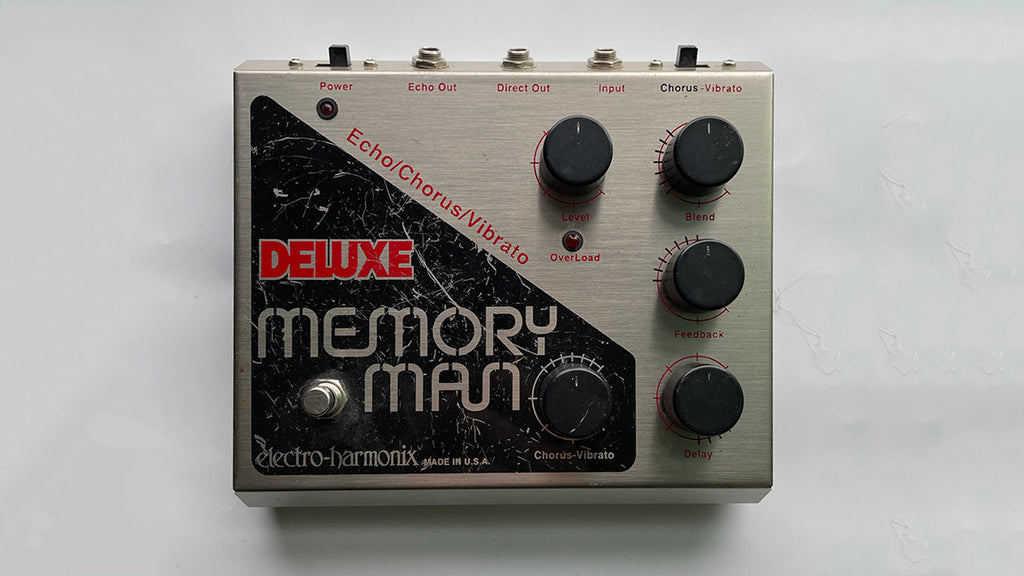Electro-Harmonix Deluxe Memory Man

Of all the relics we have around here, and in the world in general, delay is one of the most captivating and enigmatic effects. Out of everything available on our collective palette, delay is one of the only effects that impresses non-musicians. And from an engineering standpoint, it’s a triumph of sheer will. What was once only achievable via complicated mechanical means whose history is composed of magnetic tape, magnetic drums and electrolytic oil, was forged in the fire of parts developed for telephony. One of the finest examples of solid-state delay is the Electro-Harmonix Deluxe Memory Man, the pinnacle of bucket-brigade stompbox tech.
We can’t talk about delay without first talking about the bucket-brigade device (BBD), otherwise known as “bucket-brigade chips,” “bucket chips,” “BBD chips” and whatever else. Without waxing too poetic about these ICs, they essentially changed the way guitarists approached effects. Before BBDs, almost any time-based effect (barring phasers and vibratos) required the employ of physically large and daunting devices. Choruses and flangers needed a whole tape recorder and a free hand (or two), delays required lugging around a finicky tape echo unit, and reverb needed a whole amp or a clunky outboard spring unit. BBD chips changed all that, bringing the sounds of the studio to stage floors around the world, and relegating the previous methods to recording studios.
These BBD chips were developed by former Fairchild employees under a new company name—Reticon. These first BBD chips, manufactured with part numbers beginning with SAD, found their way into pedals soon after, but the raw materials were so expensive that they were produced in limited quantities. Soon, Matsushita of Japan started cranking them out at a fraction of the cost (part number prefix “MN”) and they wound up in thousands of pedals. If a particular pedal ended up migrating from SAD to MN chips, the SAD variant is worth much more money despite not sounding much different. The Memory Man is a rare exception.
For something named after memories, the Deluxe Memory Man (DMM) fittingly has created many. The first example of the line was a starkly decorated affair that looked like a frightening piece of hospital equipment. Perhaps better known is the Stereo Memory Man, which added, well, you know. But it was the Deluxe Memory Man that stole the spotlight, adding modulation to the repeats, previously only available on tape machines that had fallen out of repair.

That chorus and vibrato was what ended up setting the DMM apart from everything else. Players quickly discovered that turning the Delay Time and Feedback to minimum yielded a lush modulation effect. And unlike most happy accidents discovered in this way, this one actually sounded amazing. Instead of equaling its contemporaries, it exceeded them in many ways; the bipolar power imparted a richness onto the tone, and nobody to my knowledge was offering a vibrato circuit at that point in time.
Like many pedals of its time, the original was hardwired for AC main power, with a bulky 24V transformer sharing the interior right next to the finer electrical componentry. While that’s fine and dandy, even in the ‘70s nobody wanted to run a bulky power strip flanked by a battery of thick IEC cables with questionable strain relief for the semblance of a pedal board, or mix and match with batteries and power cables. In an era of power bricks, this also makes modern, streamlined pedalboard integration tricky. Once Mike Matthews returned from Russia to reboot Electro-Harmonix in the ‘90s, a reissue using the same chips emerged, this one using a more fashionable external transformer, making it easier to tuck under a pedalboard. Just don’t lose it.
One interesting side effect of the DMM’s rise to prominence is one of the first examples of consumer component familiarity and topological recognizance. Long after the DMM fell out of production and prices went up, suddenly the MN3005 (and to a lesser extent the MN3008, used in later reissues)—the DMM’s device of choice—was the only chip in the BBD world that mattered to anyone. And it extended far past the DMM; suddenly the MN3005 was the reason the Boss DM-2 sounded any good, despite being the rarer of the BBD chips offered in that unit. And if you were making a new analog delay, if you weren’t sitting on a huge stash of MN3005s (or MN3008s), you weren’t moving units.
As a footnote in the DMM saga, the MN3005 went obsolete sometime in the ‘90s, and all remaining pieces were bought up by pedal companies. When these stocks dried up, some manufacturers (Electro-Harmonix included) reached for the more readily-available MN3008. As demand rose and supply dwindled, Asian company XVive actually started reproducing MN3005s—nigh unheard of in the IC world, especially in a field as niche as ours. The first pedal to receive them was one of XVive’s own pedals, the Memory, designed by Howard Davis, original engineer of the Memory Man. That’s serendipity, baby.
